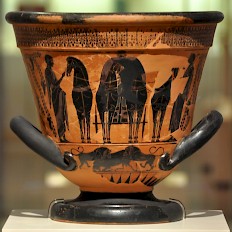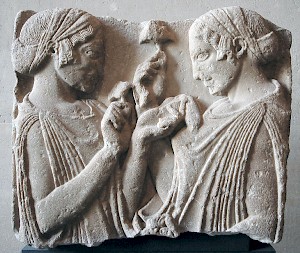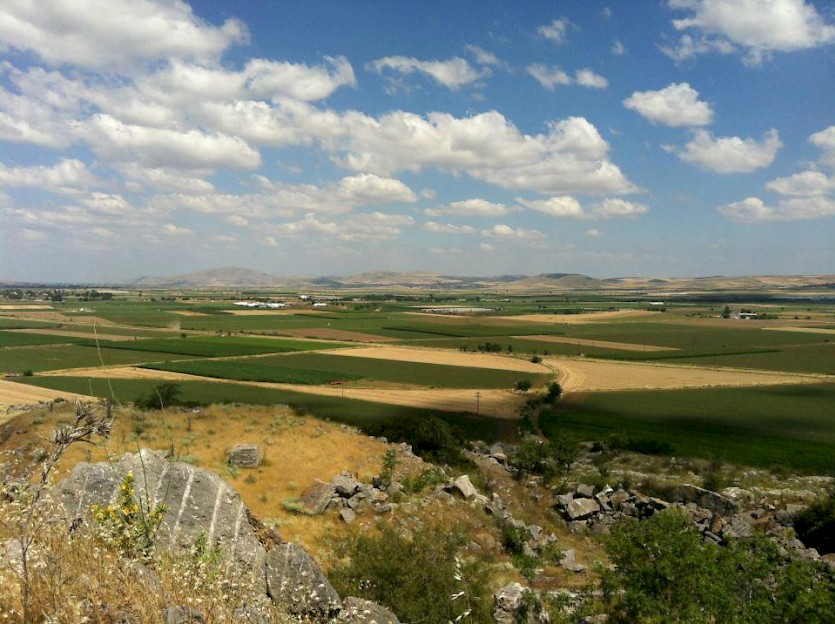Pharsalus
Q38281085Pharsalus: Greek town in Thessaly, well-known for the famous battle in 48 BCE in which the Roman general Julius Caesar defeated his opponent Pompey the Great.

Pharsalus was the main city of Phthia, the southeastern part of the Thessalian plain, which is dominated by the river Enipeus and the Othrys mountains. In the archaic age, the town was governed by an aristocratic family that was known as the Echecratids. They survived as rulers into the classical age, as was usual in Thessaly. (For example, in Larisa and Crannon, the Aleuads and Scopads remained in power.) These families tried to obtain the office of tagos, which meant that they were some sort of "first among equals" in the Thessalian nobility.
In the sixth and early fifth century, the Aleuads of Larisa were the most important clan, but immediately after Xerxes' invasion of Greece (480-479), the Spartan king Leotychidas led an army to the north to punish the Aleuads for collaboration, and put an end to their seizure of the tageia. It seems that Echecratidas of Pharsalus was the new tagos. It is possible that in this period, an identification was made between the fifth-century region of Phthia and the country of the same name that is mentioned in Homer's Iliad as the homeland of Achilles.

Echecratidas could not pass his office to his son Orestes, who was exiled in c.455 and unable to come back, even though he was supported by the powerful Athenians. About fifteen years later, the tageia was held by a man from another Pharsalian family, Daochos. In an inscription that was later erected, it is stated that "he ruled according to the law and not by the use of force", a compliment that shows that city life developed slowly. Daochos appears to have been ruler of Pharsalus and tagos until 413.
At the beginning of the Peloponnesian War, in 431, the Thessalians sent troops to help Athens against Sparta. The leader of the Pharsalian contingent was a man name Meno, who may or may not have been a relative of the Thessalian Meno who gave his name to a dialogue by the philosopher Plato.
In the fourth century, the process of urbanization -slow in comparison to central Greece- continued and Pharsalus built a city wall. However, there was also some centralization in Thessaly, and Larisa and Pherae both wanted to be the real Thessalian capital. In 395, Medius of Larisa, who was at war with Lycophron of Pherae, captured Pharsalus, and expelled a Spartan garrison that may have been there since the Decelean or Ionian War (413-404). The capture of Pharsalus was one of the first operations in the Corinthian War, in which the Boeotians, Athenians, Corinthians, Argives, and Larisans fought against the Spartans and Pheraeans.
Twenty years later, Jason, the son of Lycophron of Pherae, conquered Pharsalos, and another twenty years later, king Philip II of Macedonia added all of Thessaly to his dominions, accepting the tageia for himself (352). Six years later, he captured the port of Halos and gave it to Pharsalus, which from now on had access to the sea. Still, the Pharsalians did not like the Macedonians: after the death of Philip's son Alexander the Great in 323, they joined the Greek coalition that in vain tried to cast off the Macedonian yoke in the Lamian War. It appears to have remained unpunished when Antipater had restored order in the summer of 322, but in 304 Halos was refounded, something that the Pharsalians will not have appreciated.

Like other Thessalian towns, Pharsalus joined the Aetolian League in 266; it was briefly reoccupied by the Macedonian king Philip V in 198, was garisoned by the Seleucid ruler Antiochus III the Great during the Syrian War, and was added to the Thessalian League by the Romans in 189. When Rome subdued Macedonia and Greece in the mid-second century, Pharsalus was included too. In August 48 BCE, it was the site of the decisive battle in the civil war between the Roman general Julius Caesar and his rival Pompey the Great, which marked the end of the Roman republic.
In late Antiquity, Pharsalus is mentioned as the residence of a bishop. In the sixth century, the emperor Justinian rebuilt the walls of the town.